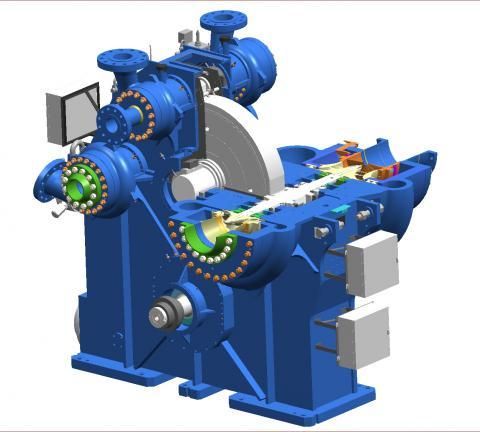How blade vibration impacts integrally-geared compressors

In today’s competitive world, integrally-geared technology can provide low-initial-cost and compact solutions compared to conventional compressors. Plant designers are searching for ways to be more competitive, and integrally geared compressors are providing ways to reduce initial costs and overall footprint. Additional savings can be achieved by taking advantage of unique features, such as the 3-D semi-open impellers, variable inlet-guide-vanes and variable diffusers.
The integrally-geared design can allow new advantages such as fewer stages and slightly higher efficiency. And a 3-D semi-open impeller generally has a higher efficiency at its optimum point, which could also offer a higher volume coefficient (compared to a closed-type impeller). They are also different than conventional impellers in terms of dynamic behavior and vibration modes.
The distribution of power and load to the individual impellers plays an important role in the dynamic behavior of an integrally-geared compressor. This load distribution can depend on many factors. Normally, the first stages can be subjected to a somewhat higher load. Considering higher loads and larger sizes, more attention could be required on the first impellers. Usually, two semi-open impellers are configured on one pinion shaft. The design based on four pinion shafts (for a total of eight semi-open impellers) is a common arrangement. Designs with 10 semi-open impellers are also used.
Supercritical operation
Shaft speeds and impeller diameters should be selected to achieve an optimum performance (an optimum speed for two impellers on each pinion shaft). High speeds for impellers are very common, which result in a more compact machine. High reference pitch line velocities in gear teeth (for instance, above 200 m/s) could be employed. This approach generally results in a supercritical operation of an integrally geared compressor.
Rotors should pass lateral natural frequencies of the rotor-bearing system during machine start-up and coast-down. For some stages, an operating speed between the second critical speed and third critical speed is used (perhaps about 20% to 25% below the third critical speed). Super-critically running flexible rotors operated beyond the first natural frequency should be high-speed balanced at the operating speed of the original bearings after they have been pre-balanced at low speed. In addition, lightly-damped natural frequencies can be excited at the operating speed by radial gas pressure components from the gas side (the impeller/shaft seal) which vibrate at sub-synchronous frequencies.
Generally, sophisticated tilting-pad journals are used to battle bearing-related-instabilities. The resulting axial gas forces and possible axial forces from the pinion (single helical teeth) are either absorbed by one thrust bearing for each pinion shaft or by specially designed shaft shoulders (also called “thrust collars”). The shaft shoulders are located close to tooth mesh, which transfer the thrust forces to the bull-gear at a relatively low sliding speed. The low-speed bull-gear shaft should be provided with a common combination of axial and radial bearings.
Dynamic behavior
One of the key topics in the design of 3-D “semi-open” impellers is the mechanical and dynamic analysis for preventing bursting, creeping, fatigue, and other problems (such as a contact with casing and a performance reduction because of relatively high-speed and relatively large deformations). In addition, variable-speed 3-D “semi-open” impellers are becoming more common (for instance, in the form of variable-speed integrally-geared compressors or a variable-speed conventional compressor with a first stage semi-open impeller). Therefore, it is important to have a good understanding of blade vibration to define a blade geometry that can operate over a wide speed range.
The 3-D semi-open blades suffer many excitations during operation, such as unsteady aerodynamic excitation forces, torque fluctuations, and others. They offer different types of vibration modes, for example, blade-hub (disk) coupled modes and blade-shaft (torsional, longitudinal) coupled modes.
Advanced theoretical studies and modern experimental methods should be employed for 3-D semi-open impeller coupled-vibrations and the identification of modes which are more likely to be excited. Recent studies have showed that the torque and gas pressure fluctuations are more likely to excite the 3-D semi-open blade-shaft coupled modes. Impact excitations and propagating fluid pressure fluctuations are more likely to excite blade-hub coupled modes.
In conclusion, torque fluctuations, impact excitations and fluid pressure fluctuations could affect the dynamics of 3-D semi-open impellers. Torque and pressure fluctuations can possibly excite the resonance of blade-shaft (torsional, longitudinal) coupled modes, and the vibration could be large when the natural frequency of a blade-shaft (torsional) coupled mode is close to that of the 1
st
bending mode of a blade. On the other hand, the impact excitations and propagating gas pressure fluctuations (fluctuations propagating circumferentially around the 3-D impellers) may excite the resonance of blade hub (disk) coupled modes.
(The author is a Chartered Professional Engineer in Australia, Queensland and U.K. An M.Sc. and B.Sc. graduate in mechanical engineering, he is a senior consultant specializing in rotating equipment, condition monitoring and reliability).